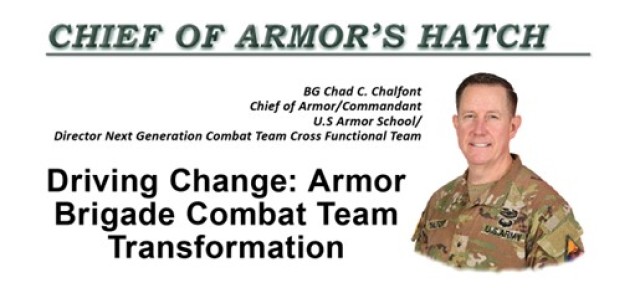In this article, I’d like to briefly describe our ongoing efforts to transform the Armored Brigade Combat Team. There is little uncertainty about the need to adapt how we organize, equip, and train our armored formations. Over the last several years, articles in this publication have (rightly) highlighted the key features of today’s and future battlefields, where our formations will operate under conditions of constant observation, greater lethality, and with greater frontages and depths. We are driving action today to make our formations more lethal, more survivable, and ready for the next fight. The remainder of this article outlines what we are doing over the next twelve to eighteen months to transform the ABCT.
Transformation in Contact (TiC) 2.0 answers this question: how can we rapidly adapt our formations to make them more lethal, with the capabilities and technologies available today? To do this, the Army has focused on two levers: the infusion of technology directly into our tactical units and adapting the organizational design of these same formations. The Army has designated two pairs of ABCTs as TiC ABCTs: 2/1 CD and 2/3 ID (with NTC rotations in Fall 2025 and early Summer 2026, respectively) and 1/1 CD and 2/3 ID (with NTC rotations in 2027). All four of these ABCTs will be fielded with a range of materiel capabilities for their home station training and NTC rotations. These technology infusions focus on improving the ABCT’s ability to sense, strike, protect, and conduct command and control.
Each of these ABCTs will also experiment with organizational design changes that will increase the fighting capability of their formations. Key formations under consideration include the
1) Multi-Functional Reconnaissance Company (brigade-level sense and strike arm); 2) the multi-Purpose Company (battalion-level sense and strike arm); and 3) the Armored Strike Platoon (ASP). The ASP is a battalion-echelon specialty platoon that employs air and ground unmanned systems. Put another way, the ASP serves as the landing spot for unmanned systems as they are fielded to the ABCT.
Finally, our branch will drive action and collaboration on ABCT TiC 2.0 efforts using the Armored Transformation and Standardization Initiative (ATSI). Over the past year, the ATSI has focused on creating, developing, and enforcing the Armor Force’s training standards. Over the next twelve months, the ATSI will expand its scope to address ABCT transformation. In addition to pursuing training standards, our monthly ATSI councils will now include opportunities for leader dialogue/ collaboration and drive on priorities of work necessary for near-term transformation of our ABCTs.
Even as our mounted formations drive change through Transformation in Contact, our community must continue to invest in reinforcing our training standards. Examples of ongoing ATSI efforts include: 1) establishing UAS, CUAS, and emissions control training standards for our tactical units and our doctrine; 2) implementing the Maintenance Skills Test to reinforce crew-level maintenance proficiency; 3) implementing our new gunnery standards for the Abrams and Bradley platforms; 4) continuing the 1st Cavalry Division pilot of the Standardized Armored Based of Training (SABOT) program; 5) receiving feedback from the field on doctrine development efforts; and 6) improving tank and Bradley field-level maintenance training proficiency.
This is truly an eventful time in the Armored Force and across the US Army as we drive Continuous Transformation. The Armor School is always ready to partner with you as you drive readiness and work towards transforming our formations. And as always, if you need anything from the Armor School, just holler!
Forge the Thunderbolt!
Click here to return to the table of contents:
https://www.benning.army.mil/armor/earmor/content/issues/2025/fall/


Social Sharing